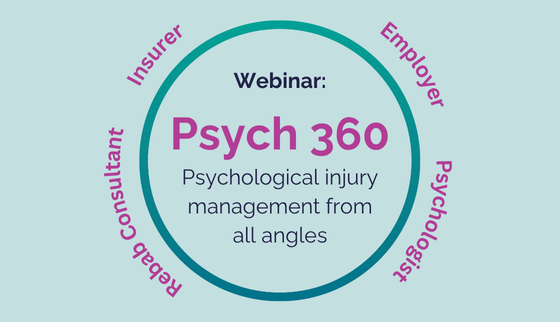Today, one in five workers in Australia are experiencing mental illness.
So chances are one of your team could be experiencing body image issues or an eating disorder.
And while they aren’t the same thing, they can be connected.
Not all eating disorders are caused by body image issues, but negative body issues can increase the risk of developing an eating disorder.
It’s a common misconception that these issues only affect women and girls.
Many men and boys have body image concerns and eating disorders, and the numbers are consistently rising.
As an employer, it’s up to you to promote and provide a mentally healthy work environment.
Your team need to feel supported, and it’s important to help them build their skills and resilience.
Raising awareness and having conversations is a great place to start and help reduce the stigma of mental illness.
As well as the personal toll that body image issues and eating disorders have, there’s also a significant economic toll and impact on workplace productivity.
A recent study released by Deloitte Australia uncovered some pretty startling figures on the impact eating disorders are having on the Australian workplace.
It estimated that around 1.1 million Australians had an eating disorder in the 2023 financial year.
These people lose an additional 10 days of work per year.
And it may surprise you to learn that more than one-third of Australians living with an eating disorder are men.
In this TED Talk, Amber Jordan explores how food and body shame affect workplace potential, including the impact on male team members.
What are eating disorders?
An eating disorder is a mental health condition that affects the way someone eats.
This might mean eating too little, avoiding certain foods, or eating large amounts in one go.
It’s often linked to an intense fear of gaining weight.
Eating disorders can be hard to overcome and, in some cases, even be life-threatening.
There are three different types of eating disorders:
1. Anorexia nervosa
Anorexia nervosa involves having a distorted view of your body and going to extremes with dieting, often leading to serious weight loss.
2. Binge-eating disorder
Binge-eating disorder (BED) is when someone regularly eats a lot of food in a short amount of time and can’t stop even if they are feeling full or want to stop. It’s different from just overeating every now and then, like during holidays.
3. Bulimia nervosa
Bulimia nervosa involves cycles of binge eating followed by things like making yourself throw up, using laxatives, or working out too much to try and prevent weight gain.

How do eating disorders and body issues affect men?
The myth is that men aren’t affected by eating disorders.
This misconception means that not only do the warning signs go unnoticed, men are also less likely to reach out and get the support they need.
But they need support more than ever.
- More than one-third of Australians living with an eating disorder are male.
- Men are four times more likely to live with an undiagnosed eating disorder.
- The prevalence of eating disorders in men has grown by almost 33,000 since 2012.
- 24% of boys aged 12-18 in Australia report a high level of body dissatisfaction.
(Source: butterfly.org.au)
These are pretty surprising stats, but it’s no surprise to learn that eating disorders differ for men.
One of the main body issues that’s more common in men is dissatisfaction with their bodies and a perceived lack of muscle definition.
When someone becomes fixated on looking more muscular or lean, it’s termed muscle dysmorphia.
It’s a type of body dysmorphic disorder – a mental health condition where someone becomes overly focused on parts of their appearance they see as flawed or unattractive.
Strictly speaking, they aren’t eating disorders.
They’re actually anxiety disorders.
But they can happen alongside eating disorders.

How to recognise signs and symptoms
It’s not easy.
Many people with eating disorders can often seem like an ideal employee with perfectionist traits, being highly driven and having high attention to detail.
However, to appear highly functioning on the surface can take a great emotional and mental toll, which is unseen.
Having said this, as a leader, you can play a crucial role in implementing policies and practices that support your employee’s wellbeing.
Here are some signs that a colleague may have an eating disorder or body image issue:
- Noticeable weight loss or gain.
- Constantly thinking about food, skipping meals, eating oddly small or large portions, or having strict food routines.
- Leaving evidence of binge eating, like large numbers of food wrappers and containers in the bin.
- Trouble focusing or staying on task.
- Pulling away from coworkers or becoming more isolated.
- Being overly focused on getting everything perfect, whether in work or personal standards.
- Consistently taking trips to the bathroom soon after eating.
- Exercising excessively, even when tired or unwell.
- Frequently giving reasons for not eating (like saying they already ate or feel sick).
- Making critical comments about their own body or other people’s appearance.
- Taking a lot of sick days or unexplained time off.
- Avoiding work events or social gatherings that involve food.
- Always checking mirrors or reflective surfaces or grooming excessively.
- Talking a lot about gaining muscle or looking a certain way physically.
- Comparing their appearance to others or obsessing over flaws that seem minor or invisible to everyone else.

How to support your team members
There are many ways you can help make your workplace a safer, more supportive space for people experiencing body image issues or eating disorders.
Don’t make assumptions based on appearance
Just because someone looks ‘fit’ or ‘fine’ doesn’t mean they aren’t struggling.
Avoid commenting on bodies or food choices
Even well-meaning comments like, ‘You’ve lost weight’ or ‘That’s a big lunch’ can trigger anxiety around eating and appearance.
Be mindful of workplace culture
Watch for toxic ‘banter’ around diets, gym habits, or appearance. Promote a culture where everyone feels accepted as they are.
Make space for mental health conversations
Let your team know it’s okay to talk about mental health, including issues like body image and eating disorders, without judgment.
Respect privacy but show care
If you’re concerned, check in gently and privately. Try something like, ‘I’ve noticed you’ve seemed a bit off lately. I just wanted to see how you’re doing’.
Challenge stereotypes
Many men feel pressure to stay silent because of the idea that eating disorders are a ‘female’ issue. Emphasise that anyone can struggle and it’s okay to get help.
Offer flexibility
Flexible hours or private spaces to eat can make a huge difference if someone is in treatment or recovery.
Share support resources
Make sure team members know where to find help. You could share links to confidential EAP programs or counselling services.

Body image issues and eating disorders can be severe and even-life-threatening.
So it’s important to remember that it’s not up to you to solve anything.
Just listening and showing empathy can go a long way.
If someone needs help, getting assistance from a professional psychologist or a mental health support service can provide emotional support as well as develop strategies to help that person cope and hopefully overcome their body image issues or eating disorders.
For more information and resources on body image issues and eating disorders, we found these sources helpful:
- Support for eating disorders and body image issues – Butterfly
- Body image: men – Better Health Victoria
- Eating disorders – American Psychiatric Association Center for Workplace Mental Health
- Services and support for eating disorder recovery – Eating Disorders Victoria
Useful articles:
- Eating disorders in the workplace – Butterfly
- Men, boys, body image, and eating disorders – Butterfly
- Body image issues in men – Eating Disorders Victoria
- Paying the price: The economic and social impact of eating disorders in Australia – Deloitte Access Economics



